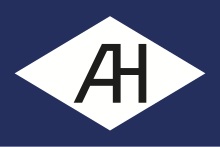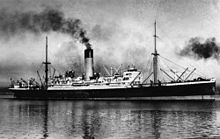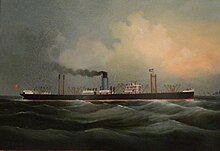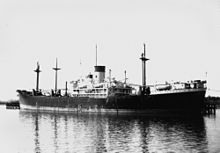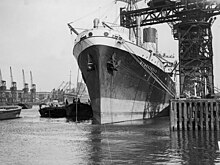
A steamship, often referred to as a steamer, is a type of steam-powered vessel, typically ocean-faring and seaworthy, that is propelled by one or more steam engines that typically move (turn) propellers or paddlewheels. The first steamships came into practical usage during the early 1800s; however, there were exceptions that came before. Steamships usually use the prefix designations of "PS" for paddle steamer or "SS" for screw steamer. As paddle steamers became less common, "SS" is assumed by many to stand for "steamship". Ships powered by internal combustion engines use a prefix such as "MV" for motor vessel, so it is not correct to use "SS" for most modern vessels.
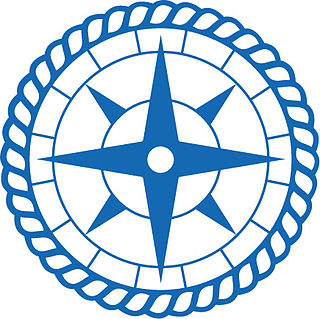
Outward Bound (OB) is an international network of outdoor education organizations that was founded in the United Kingdom by Lawrence Holt and Kurt Hahn in 1941. Today there are organizations, called schools, in over 35 countries which are attended by more than 150,000 people each year. Outward Bound International is a non-profit membership and licensing organisation for the international network of Outward Bound schools. The Outward Bound Trust is an educational charity established in 1946 to operate the schools in the United Kingdom. Separate organizations operate the schools in each of the other countries in which Outward Bound operates.

An ocean liner is a type of passenger ship primarily used for transportation across seas or oceans. Ocean liners may also carry cargo or mail, and may sometimes be used for other purposes. Only one ocean liner remains in service today.

The Blue Star Line was a British passenger and cargo shipping company formed in 1911, being in operation until 1998.

The Union-Castle Line was a British shipping line that operated a fleet of passenger liners and cargo ships between Europe and Africa from 1900 to 1977. It was formed from the merger of the Union Line and Castle Shipping Line.

Victoria Alexandrina Drummond, MBE, was the first woman marine engineer in the UK and the first woman member of Institute of Marine Engineers. In World War II she served at sea as an engineering officer in the British Merchant Navy and received awards for bravery under enemy fire.

Ellerman Lines was a UK cargo and passenger shipping company that operated from the late nineteenth century and into the twentieth century. It was founded in the late 19th century, and continued to expand by acquiring smaller shipping lines until it became one of the largest shipping firms in the World. Setbacks occurred through heavy losses to its merchant fleet in the First and Second World Wars but were overcome in each case.
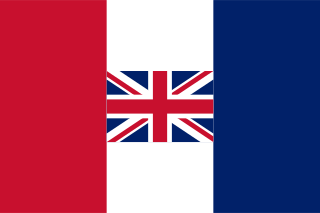
P Henderson & Company, also known as Paddy Henderson, was a ship owning and management company based in Glasgow, Scotland and operating to Burma. Patrick Henderson started business in Glasgow as a merchant at the age of 25 in 1834. He had three brothers. Two were merchants working for an agent in the Italian port of Leghorn; the third, George, was a sea captain with his own ship.
SS Antenor was a UK steam turbine passenger and refrigerated cargo liner launched in 1924. She was the third of five ships to bear the name.

Elder Dempster Lines was a UK shipping company that traded from 1932 to 2000, but had its origins in the mid-19th century.
Lawrence Durning Holt was a businessman with interests in shipping. Together with Kurt Hahn, he founded the Outward Bound organisation.
SS Patroclus was a UK steam turbine passenger and refrigerated cargo liner launched in 1923. She was the third of five ships to bear the name.
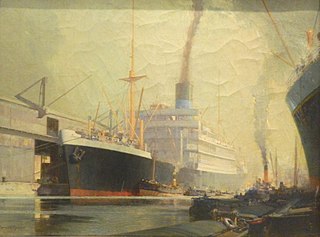
SS Sarpedon was a UK steam turbine passenger and refrigerated cargo liner launched in 1923. She was the fourth of six ships to bear the name.

HMS Hector was a UK steam turbine passenger and refrigerated cargo liner launched in 1924. She was the fourth of six civilian ships to bear the name.

The first RMS Saxonia was a passenger ship of the British Cunard Line. Between 1900 and 1925, Saxonia operated on North Atlantic and Mediterranean passenger routes, and she saw military service during World War I (1914–1918).

Alfred Holt was a British engineer, ship owner and merchant. He lived at Crofton, Sudley Road, Aigburth in Liverpool, England. Holt is credited with establishing the long distance steamship by developing a type that replaced sailing clippers on the route from Britain to China.
SS Clan Macarthur was a British refrigerated cargo steamship. She was built for Cayzer, Irvine and Company's Clan Line Steamers Ltd as one of its Cameron-class steamships. She was launched in Greenock in 1936 and sunk in the Indian Ocean by enemy action in August 1943.
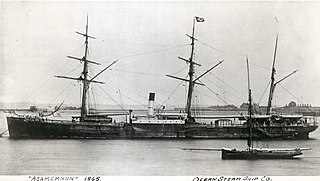
SS Agamemnon was one of the first successful long-distance merchant steamships. She was built in 1865 to trade between Britain and China, and competed with tea clippers before and after the opening of the Suez Canal in 1869. She brought together three improvements in steamship design: higher boiler pressure, an efficient and compact compound steam engine, and a hull form with modest power requirements.

Lamport and Holt was a UK merchant shipping line. It was founded as a partnership in 1845, reconstituted as a limited company in 1911 and ceased trading in 1991.
SS Tyndareus was a British steamship that was built in 1914–15 as a cargo liner for the Blue Funnel Line of the Ocean Steamship Company. Completed during the First World War, she served as a troop ship and was nearly sunk by a German naval mine, but without loss of life. Between the wars she operated commercially in the Pacific Ocean, before returning to military service in the Second World War. Her final civil role was to carry Islamic pilgrims from Indonesia to Mecca, before being scrapped in 1960.
